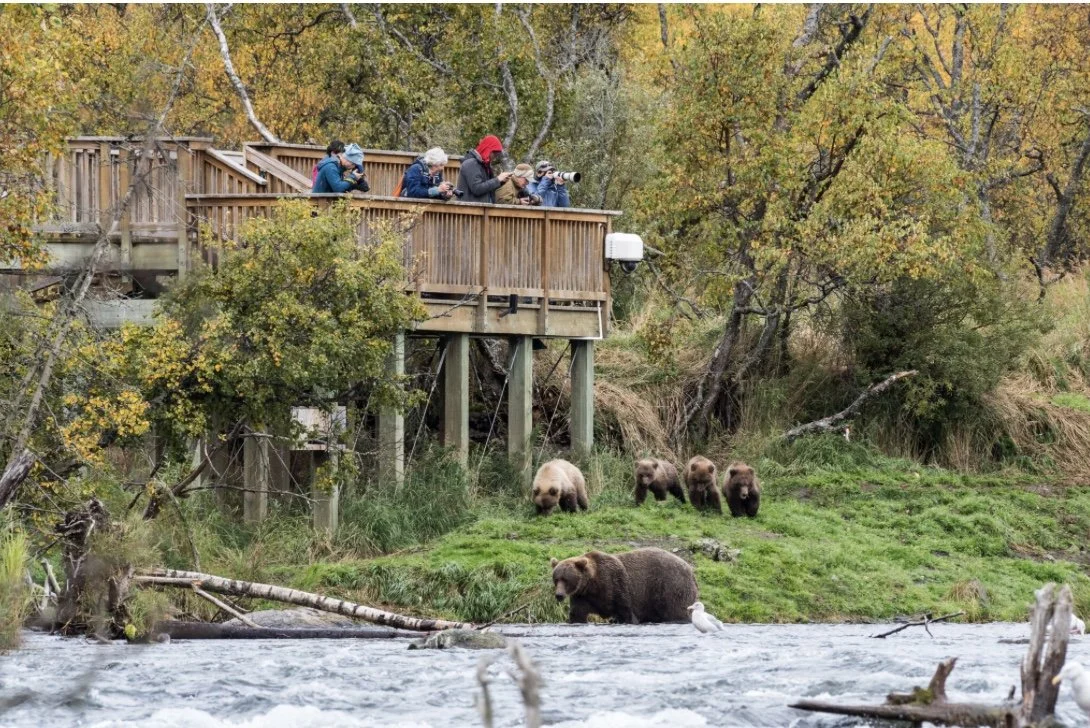Commentary: The Alaskans who keep our national parks running are needed
A mother bear known as Bear 402 and her cubs are seen on Sept. 26, 2018, below a viewing platform at Brooks Camp in Katmai National Park and Preserve. The Brooks Camp site, at the salmon-rich Brooks River, is a world-famous destination for bear viewing. (Photo by R. Service)
By Fran Ulmer
Like many other Alaskans, I love our national parks. Their beauty, wildlife and opportunities for adventures are a great gift to current and future Alaskans, as well as our many visitors. From Denali to Katmai to Glacier Bay, these special places help drive a thriving tourism economy and support reliable, made-in-Alaska jobs. Unfortunately, Alaska’s national parks and the economic benefits they bring are threatened by drastic staffing and budget cuts to the National Park Service. It was recently reported that the National Park Service Alaska Regional Office in Anchorage has lost an estimated one-third of its staff — more than 60 knowledgeable Alaskans — a result of downsizing the Department of Interior through pressured buyout tactics. And the federal administration has threatened additional cuts through mass firings.
Roughly 2 million people visited Alaska national parks in 2023, and more are expected this year. They spent $1.5 billion dollars and supported 23,000 jobs, according to the National Park Service. In Anchorage alone, 1 in 9 jobs is in tourism, Visit Anchorage has found. Across the country, one tax dollar invested in the Park Service returns $10 to the economy.
But national parks don’t run themselves. People are needed to keep parks running, from park rangers to contracting experts, from educators who design the visitor center exhibits to biologists who make sure that park wildlife survive and thrive.
The Alaska Regional Office provides oversight and expertise to 24 national park sites across Alaska, covering more than 50 million acres of federal land. The scale and landscape of Alaska makes the Alaska Regional Office essential. Most Alaska national park sites only have one or two resource staff and limited capacity. It doesn’t make financial sense for every park to have its own pilot and plane, geologist, or subsistence expert. The Regional Office provides support and expertise that serve all our parks.
At the Alaska Regional Office, cuts and consolidation programs have eliminated crucial positions, including the regional chief ranger overseeing law enforcement. Now there is only one staff member leading archaeology and cultural resource protection for all of Alaska’s national park sites, and just a handful of staff remain to work with Alaska Native tribes, whose culture, food security, and traditional ways of life should be respected by those parks.
The people who work in the National Park Service in Alaska are Alaskans. Their jobs bring important cash into our communities, and they are our friends and neighbors. The loss of Park Service jobs and the other federal land management agency jobs will hurt our economy and jeopardize the valuable resources of the parks. Without adequate staffing, park visitors may be at risk or at least disappointed. The tourism market is extremely competitive. It may not take too many bad experiences with deteriorating roads, dirty restrooms, inadequate information, disorganized commercial operations and absent wildlife to undermine one of the pillars of Alaska’s economy.
Sen. Lisa Murkowski has pushed hard to protect federal jobs in Alaska. In contrast, Rep. Nick Begich just voted for a $250 million cut to Park Service staff funding. We need our delegation to stand up for our national parks, our economy and our communities. It is not too late to keep our amazing national parks safe, accessible, sustainable, productive and world class.
About the Author:
Fran Ulmer has served as the mayor of Juneau, as a member of the Alaska House of Representatives, as lieutenant governor of Alaska, and chancellor of the University of Alaska Anchorage. She is a board member of the National Parks Conservation Association.
(Commentary reprinted courtesy of Alaska Beacon under Creative Commons)

